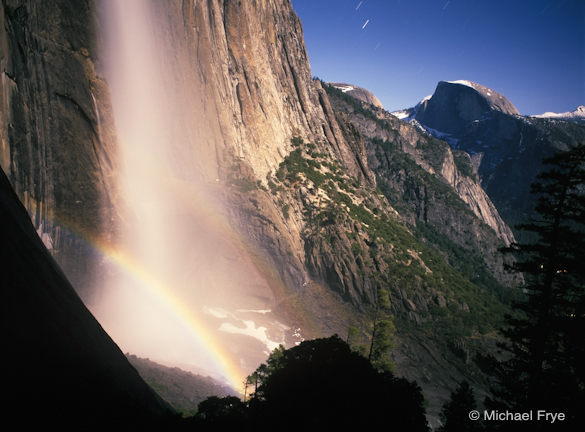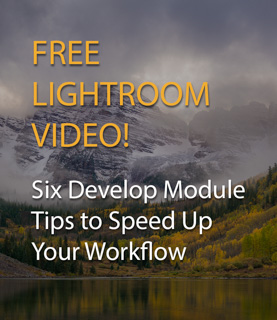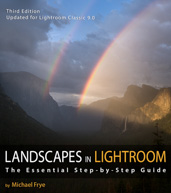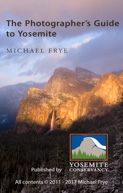In the Moment:
Michael Frye's Landscape Photography Blog
by Michael Frye | Oct 6, 2010 | Yosemite Photo Conditions
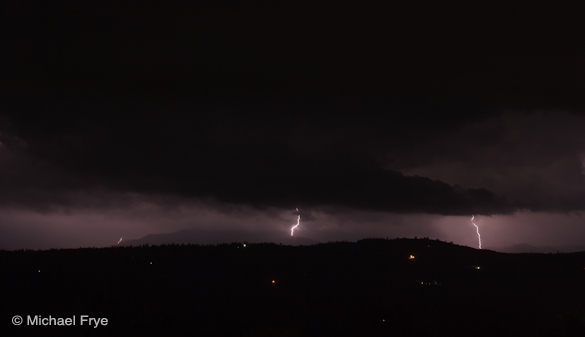
Lightning striking the Sierra foothills near Mariposa on Sunday night
October literally started with a bang, as thunderclaps rang through Yosemite Valley. It poured Saturday afternoon. Near Pohono Bridge the Merced River was brown, filled with silt, something I’ve seen only a few times in the last 27 years.
At about 11 o’clock Sunday night my wife and I got in our outdoor hot tub—a nightly ritual—and immediately noticed flashes behind the ridge to our west. We couldn’t hear anything, but knew it must be distant lightning. The frequency was impressive, a nearly constant flickering.
Even though we planned to head over Tioga Pass to Bishop the next morning, and needed to get up early, we decided to go out and take a look. We drove to a spot on Triangle Road, less than half a mile from our house in Mariposa, with a panoramic view to the south. From there we could see that flickering behind a ridge to the west, but also an even more intense thunderstorm to the south, near Fresno. This second cell put on a great light show, with nearly continuous flashes. It gradually moved closer, then slid by to the east, so we were able to watch it for over two hours.
Of course I tried to photograph the lightning, but unfortunately we saw few bolts hit the ground. Most of the show consisted of cloud-to-cloud lightning, and the streaks were usually hidden within the clouds. But I managed to capture a few good images, including the one at the top of this post.
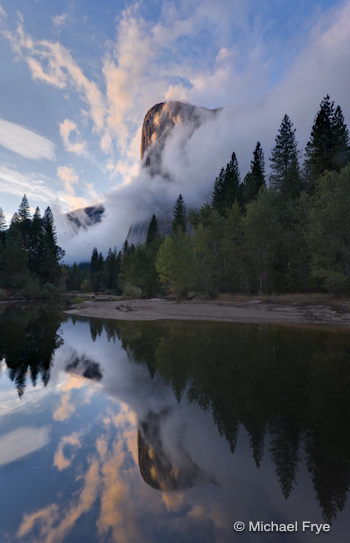
El Capitan at sunset, Tuesday evening
By the next morning rain had changed to snow at the higher elevations of the Sierra, and Tioga Pass was closed. We started driving north to Sonora Pass, but then learned that had closed too. Reluctantly we turned around rather than face a six or seven hour drive to Bishop.
I had to console myself by photographing a beautiful, seldom-visited location: Yosemite Valley. After receiving almost two inches of rain since Friday, skies cleared over the valley Tuesday, and I was able to photograph El Capitan at sunset surrounded by mist and clouds.
Since I never made it to the other side of the mountains, I can’t tell you first hand about the fall color over there, but Evan Russell, an Ansel Adams Gallery staff photographer and one of my workshop assistants, told me that the color is great west of Bishop around North Lake, South Lake, and Lake Sabrina. Or at least it was Monday. Tuesday it snowed up there, and many aspens lost their leaves. Typically a storm will strip most of the trees that are already turning, so it may be another week or two until the trees that are now green will change and provide another dose of fall color.
News like this—that some of the early season aspen spots may lose their leaves—often elicits anxious comments in forums, with people worried that they may have missed fall, and others adding fuel to the angst by saying that if you don’t go right now, or better still, yesterday, you’ll miss the most fantastic, wondrous, amazing fall color ever!
Let me assure you that fall isn’t over in the Sierra. Most of the aspens in classic eastern Sierra spots like McGee Creek, June Lake Loop, Lee Vining Canyon, and Lundy Canyon are still green, and probably weren’t adversely affected by the recent storms. While there are no guarantees—there are many little-understood factors that affect fall foliage—chances are good that these areas will produce wonderful color later in the month. I’ve made many of my best aspen photographs during the third week of October. Here’s one example.
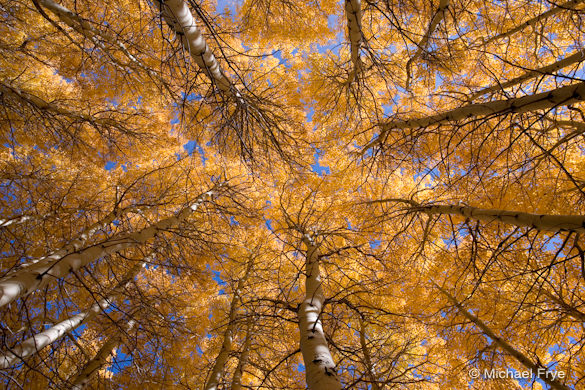
Aspen Grove, June Lake Loop, October 23rd, 2006
And if the aspens don’t produce more great color this year, there are always maples, dogwoods, oaks, and cottonwoods in Yosemite Valley. Peak fall foliage in the valley doesn’t usually occur until the end of October or beginning of November, but the rain and cold temperatures have set things in motion, and many maples and dogwoods have already started to change color. It looks like autumn might arrive early in the valley this year, but these things are always hard to predict.
I’m hoping to try again to get over to the east side later this week, so I’ll let you know what I find. In the mean time, a good resource for fall color reports is the Calphoto web site. Also, if you’ve been photographing aspens recently, or captured some of the storm activity in Yosemite, please use the comments to tell us what you found, and post links to photos!
by Michael Frye | Apr 25, 2010 | Advanced Techniques, Photography Tips
Half Dome and Upper Yosemite Fall with a lunar rainbow
In Friday’s post on my other blog I described some of my experiences attempting to photograph lunar rainbows, but here are some tips for capturing your own moonbow images.
The moon will become full at 5:19 Wednesday morning, so Tuesday night will provide the brightest moonlight, and the best chance to photograph a lunar rainbow this month—if the weather cooperates. Unfortunately the forecast calls for rain. If the predictions are faulty, and some moonlight manages to break through the clouds, cool temperatures will probably limit the amount of spray on Upper Yosemite Fall, so Lower Yosemite Fall may work better. For the upper fall, you might be better off waiting for the next full moon on May 27th. For detailed information on times and places to photograph lunar rainbows in Yosemite, see Don Olson’s site.
For those who aspire to capture lunar rainbows, here are some tips.
Equipment
Any digital SLR will work, but full-frame sensors usually produce less noise and work better for the long exposures required at night. A sturdy tripod is essential, plus a locking cable release or electronic release. You’ll want a good flashlight or headlamp, a watch to time long exposures, and a cloth for wiping spray off the lens if you’re at the lower fall. Long exposures drain batteries quickly, so make sure your camera battery is fully charged—and your spare too.
Focus and Depth of Field
To make exposure times reasonably short, you’ll have to keep your aperture wide open, or close to it. That means you won’t get much depth of field, so try to exclude foregrounds from your compositions. This shallow depth of field makes focusing critical. It’s obviously difficult to focus manually in the dark, and autofocus won’t work either. In the past I’d just manually set the lens at infinity, but many lenses now focus past infinity, making the correct focusing point difficult to determine. The solution is to find something distant that’s bright enough to focus on, like the moon itself, car headlights, or perhaps a bright light that you place far away. Then focus on that bright spot, using either manual or autofocus. The most precise method is probably focusing manually during a zoomed-in look in live view. Once you’ve set the focus, turn autofocus off and don’t touch the focusing ring—leave the lens set at this distance for all your images. You might even tape the focusing ring so it doesn’t move. (more…)
by Michael Frye | Sep 12, 2009 | Yosemite Photo Conditions
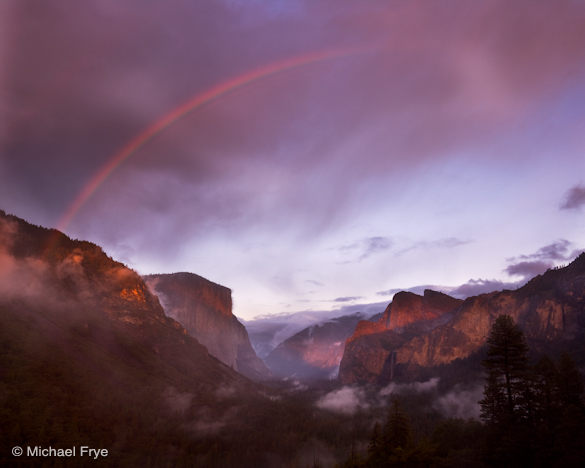
Rainbow over Yosemite Valley from Tunnel View, October 4th, 2008
As the days get shorter and cooler, the photo opportunities in the Yosemite area get hotter. It’s time to take a look at what to expect during the next few months.
September
 You won’t find much autumn color in Yosemite before October, but the indian rhubarb in Bridalveil and Leidig Meadows can add an early splash of yellow, as in this photo from the west end of Leidig. Near the fall equinox on September 22nd, and for a couple of weeks afterward, the sun sets at a good angle for Tunnel View, lighting both El Capitan on the left and Cathedral Rocks on the right. The two or three weeks before the spring equinox are even better, as there’s usually water in Bridalveil Fall, but fall can be great in the right weather conditions, like last year when I saw the rainbow at the top of this post.
You won’t find much autumn color in Yosemite before October, but the indian rhubarb in Bridalveil and Leidig Meadows can add an early splash of yellow, as in this photo from the west end of Leidig. Near the fall equinox on September 22nd, and for a couple of weeks afterward, the sun sets at a good angle for Tunnel View, lighting both El Capitan on the left and Cathedral Rocks on the right. The two or three weeks before the spring equinox are even better, as there’s usually water in Bridalveil Fall, but fall can be great in the right weather conditions, like last year when I saw the rainbow at the top of this post.
On the east side of the Sierra Nevada the high-elevation aspens usually start turning yellow in late September. The Bishop Creek area, west of Bishop, and Convict Lake, just south of Mammoth Lakes, are two of the early season hot spots. The road to Virginia Lakes, north of Lee Vining, can also have early fall color.
October
 In a typical year, the aspen color show progresses down the mountainsides on the east side of the range and reaches the lowest elevations near the third week of October. There’s no real peak, because the timing of the best color depends on the location. I prefer photographing the larger trees at lower elevations, so the third week is often my favorite time, but there’s usually plenty to photograph earlier in the month as well. Some of my favorite spots are Lundy Canyon, Lee Vining Canyon (right), and the June Lake Loop.
In a typical year, the aspen color show progresses down the mountainsides on the east side of the range and reaches the lowest elevations near the third week of October. There’s no real peak, because the timing of the best color depends on the location. I prefer photographing the larger trees at lower elevations, so the third week is often my favorite time, but there’s usually plenty to photograph earlier in the month as well. Some of my favorite spots are Lundy Canyon, Lee Vining Canyon (right), and the June Lake Loop.
The maples, dogwoods, cottonwoods, and oaks in Yosemite Valley usually turn a bit later. The peak color typically arrives around the end of October or beginning of November. Dogwoods can can often be found turning gold or even red by mid-October at higher elevations along Highway 41, Highway 120 west of Crane Flat, and in the Tuolumne Grove.
Blueberry bushes lining the shores of Siesta Lake along the Tioga Pass Road also turn red and orange near the middle of the month (below). From Taft Point, a one-mile hike from the Glacier Point Road, the late-afternoon sun strikes El Capitan at a great angle.

November
This might be my favorite month in Yosemite Valley. The peak autumn color frequently arrives at the beginning of the month and yellow and gold leaves often linger for weeks afterward. Frost and ice begin forming in the meadows and along the creeks and rivers, and sometimes an early snowfall spices up the landscape. Sunlight has already reached winter angles, raking across the face of Half Dome in the late afternoon and turning El Capitan gold at sunset.
For more detailed information, including directions to most of the locations mentioned here, pick up a copy of my book The Photographer’s Guide to Yosemite.
Addendum, September 2011: Now The Photographer’s Guide to Yosemite is available as an iPhone app!
by Michael Frye | May 9, 2009 | Photography Tips, Yosemite Photo Conditions
 Last night I joined the throngs in Cook’s Meadow to photograph the lunar rainbow on Upper Yosemite Fall. There were at least 100 photographers around the meadow, and probably many more at the bridge below Lower Yosemite Fall. Like Horsetail Fall in February, lunar rainbows have become a photographic phenomenon. Until recently the most popular place was at Lower Yosemite Fall, but since Don Olson published specific times for seeing the “moonbow” from the Sentinel Bridge in Cook’s Meadow this spot has attracted lots of photographers. The big advantage is that it’s dry! At the bridge below Lower Yosemite Fall it’s impossible to keep mist off the front of the lens.
Last night I joined the throngs in Cook’s Meadow to photograph the lunar rainbow on Upper Yosemite Fall. There were at least 100 photographers around the meadow, and probably many more at the bridge below Lower Yosemite Fall. Like Horsetail Fall in February, lunar rainbows have become a photographic phenomenon. Until recently the most popular place was at Lower Yosemite Fall, but since Don Olson published specific times for seeing the “moonbow” from the Sentinel Bridge in Cook’s Meadow this spot has attracted lots of photographers. The big advantage is that it’s dry! At the bridge below Lower Yosemite Fall it’s impossible to keep mist off the front of the lens.
You can’t really see a lunar rainbow with the naked eye. Our eyes don’t render color very well in the dark, so at best you can see a bright arc and maybe a hint of color. But the color is there, and film or digital sensors capture it well. One of the reasons that more people haven’t photographed lunar rainbows from Cook’s Meadow in the past is that you can’t really see it from there. With film you’d just have to guess about the position and wait to find out whether you were right. With digital sensors it’s easy to just take a photo and see the position of the rainbow.
Last night the moon was bright enough that I could see the rainbow fairly well. Along with everyone else I watched it move down the fall as the moon rose. When the rainbow fell too low, most people packed up (it was 11:30 p.m. after all), but I followed the moon westward and saw an even more vivid rainbow from near the Yosemite Chapel. This photograph was made from that spot. Rainbows form a circle around a spot opposite the light source—sun or moon. Lunar rainbows can be seen on any waterfall that gets moonlight if you position yourself properly. In fact I photographed a lunar rainbow on Castle Geyser in Yellowstone many years ago. Maybe I’ll put that image in another post.
Long exposures with digital cameras can create lots of noise, but newer models handle this pretty well. You’re usually better off making a long exposure at a low ISO than a shorter exposure with a higher ISO. But with lunar rainbows you don’t want to make the exposure too long or the bands of color will blend together. I used a six-minute exposure at f/4 and 100 ISO for the image above. Trying to lighten a dark image will exaggerate noise, so it’s best to make the photograph as light as possible without overexposing it. Don’t rely on just how it looks on your LCD screen. Since it’s dark, the screen will look bright even if the image is underexposed. Use your histogram.
Having said that, a nighttime photograph shouldn’t be too bright. You don’t want it to look like it was taken under midday sunlight. I actually darkened this image—especially the sky—in software to give it more of a nighttime feeling.




